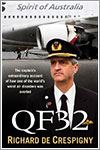
Total Pageviews
Monday 8 July 2013
US reportedly uses security agreements to intercept data from undersea fiber optic lines

BBC America going social with The Stig via branded 'Top Gear' Twitter video

Facebook Adds Folder Support to Facebook Home

Virgin Media launches Play Games portal for TiVo

El mapa de Internet en 1977
En 1977 aún era posible dibujar un mapa de Arpanet , la red creada con el fin de facilitar a los colaboradores de la Agencia de Proyectos de Investigación Avanzados de Defensa el acceso a ordenadores, que a finales de los años 60 eran un bien muy escaso.

Arpanet en 1977 - Clic para ver entero
Con el tiempo y el abaratamiento del precio de los ordenadores ese objetivo fue perdiendo sentido, siendo sustituido por el de comunicar a los usuarios mediante el correo electrónico, los grupos de noticias, la web, etc.
Claro que para entonces Arpanet había cambiado de nombre para adoptar el de Internet, una red que no se creó para sobrevivir a un ataque nuclear.
(Bruce Sterling vía Boing Boing).
- Cómo era Internet en 1969 y cómo es en 2013 en un gráfico, más retrohistoria de la Red.
- ARPAnet en 1972, un documental.
- El origen del correo electrónico la primera killer app de Internet.
- Los varios cumpleaños de Internet, porque todo depende un poco de cómo lo mires.
via Microsiervos http://www.microsiervos.com/archivo/internet/mapa-internet-en-1977.html
QF32, la historia de un vuelo que pudo acabar en desastre

![]() QF32 . Richard Champion de Crespigny. Edición Kindle, inglés. Web sobre el vuelo y el libro.
QF32 . Richard Champion de Crespigny. Edición Kindle, inglés. Web sobre el vuelo y el libro.
El 4 de noviembre de 2010 el A380 Nancy Bird-Walton de Qantas, con 469 pasajeros y tripulantes a bordo, despegaba de Singapur rumbo a Sydney para realizar el vuelo QF32 cuando a los cuatro minutos del despegue el motor número 2, el que va más pegado al fuselaje del ala izquierda, explotaba.
Aunque los motores están diseñados para que en el caso de la pérdida de alguno de los álabes de sus turbinas ningún fragmento salga al exterior esta explosión, producida por un fallo de fabricación, resultó ser mucho más grave, pues se desprendió un disco entero de la turbina, lo que hizo que multitud de fragmentos atravesaran el carenado del motor de tal forma que tanto el ala izquierda como el fuselaje recibieron múltiples impactos.

Estado en el que quedó el motor número 2
El motor número 1, sin embargo, no recibió ningún impacto porque los motores del A380 van decalados seis metros, pero tampoco sirvió de mucho porque la lluvia de metralla cortó y/o cortocircuitó unos 600 cables dentro del ala y la parte inferior izquierda del fuselaje que dejaron 20 de los 21 sistemas del avión con fallos.
De hecho aunque el comandante consiguió estabilizar el vuelo en cuestión de segundos después de la explosión del motor él y su copiloto, Matthew Hicks, necesitaron más de una hora para repasar todas las listas de comprobación que el sistema de gestión del avión les iba presentando, listas que además a menudo se solapaban cuando el ECAM detectaba un fallo más prioritario y que muchas veces no tenían mucho sentido probablemente a causa de los cables cortocircuitados y de que nadie en Airbús pensó que pudieran fallar tantas cosas a la vez.
Es cierto que en la cabina iban también Mark Johnson, que en ese vuelo iba como segundo oficial para darles el relevo al comandante y al primer oficial debido a la duración prevista del vuelo, y que además iban también en ella los comandantes David Evans y Harry Wubben, pues este último se examinaba como capitán examinador, así que los tres les pudieron echar una mano supervisando sus acciones y ofreciendo sugerencias cuando se las pidieron, pero aún así no hay que olvidar que el A380 está diseñado para ser volado por dos pilotos, que al final eran los que tenían que manejar prácticamente todo.
En un momento dado el comandante Champion de Crespigny decidió que ya estaba bien de intentar hacer caso a todas esas listas de comprobación y tomó la decisión de enfocar el problema desde el punto de vista de lo que necesitaban para aterrizar, lo que fueron comprobando poco a poco.
Aterrizar tampoco fue nada fácil, pues la superficies de control no funcionaban del todo bien, igual que ninguno de los tres motores que les quedaban, y además tenían que aterrizar con unas 41 toneladas de sobrepeso porque no funcionaba tampoco el sistema de expulsión de combustible y con unos frenos también degradados.
Aún así, a pesar de todo, consiguieron aterrizar de una pieza, aunque sus problemas distaban de haber terminado, pues con el exceso de peso los frenos estaban a más de 1.000 grados de temperatura y caía sobre ellos combustible a causa de las perforaciones del ala sin que los bomberos pudieran acercarse porque el motor número 1 se negaba a pararse, ya que no respondía a los controles.
Tan siquiera se paró cuando los bomberos intentaron ahogarlo con agua.

Los bomberos del aeropuerto de Singapur intentando parar el motor número 1
Fueron momentos tensos porque los pilotos no tenían muy claro que una evacuación, con personas mayores y niños a bordo fuera una buena idea, en especial con un motor aún en funcionamiento que podía tragarse a alguien, amén del peligro de incendio.
Pero al final, unas dos horas después de aterrizar, con el motor número 1 aún en marcha, pero con el combustible en el suelo convenientemente cubierto de espuma antifuego, todo el pasaje pudo desembarcar por el lado derecho del avión, sin que nadie sufriera daño alguno.
El motor número 1 aún tardaría algo más de una hora y media más en pararse, y sólo lo hizo cuando lo ahogaron con espuma antifuego.
Un trabajo impresionante de la tripulación técnica y de los TCP, que durante todo el tiempo fueron capaces de mantener al pasaje lo suficientemente tranquilo, algo nada fácil en las circunstancias en las que estaban, entre otras cosas porque a través de las ventanillas se veían perfectamente los agujeros que la explosión del motor número 2 había provocado en el ala, uno de ellos lo suficientemente grande como para que una persona pasara por él.
Finalmente, el 22 de abril de 2012 el Nancy Bird-Walton, tras ser sometido a reparaciones valoradas en unos 139 millones de dólares, volvió a Sydney.
Este libro, escrito por el comandante del vuelo, cuenta con todo lujo de detalle lo que pasó aquel día y cómo lo vivieron desde la cabina, al menos en la segunda parte del libro, pues la primera mitad está dedicada a una biografía suya.
En cualquier caso, un libro muy interesante, no sólo por lo que cuenta del vuelo en si sino por las reflexiones de Champion de Crespingy acerca de la filosofía de diseño de los Airbus y de cómo presentan la información a los tripulantes; de hecho el comandante dice que cree que ellos acuñaron aquel día el término fatiga ECAM.
- Qantas paraliza su flota de Airbus A380 tras un aterrizaje de emergencia en Singapur, el del QF32, por supuesto
via Microsiervos http://www.microsiervos.com/archivo/libros/qf32-la-historia-de-un-vuelo-que-pudo-acabar-en-desastre.html
Nokia Lumia 1020 spotted in yellow, white and black, replete with 2GB of RAM

Android's Jelly Bean contingent finally surpasses Gingerbread

Deus Ex's iOS spinoff launches on July 11th

Imagination Tech CEO: 'the industry needs MIPS as much as MIPS needs the industry'

iOS 7 Beta 3 Arrives for Developers

New BlackBerry Bold 9270 spotted, runs old BB7 OS

Clearwire shareholders approve buyout by Sprint

Twitter Rolls Out App Updates With DM Syncing

FIFA 13 now available for Windows Phone 8 as a Nokia exclusive

Twitter updates apps with direct message syncing and improved search results

gdgt's best deals for July 8: Brother InkJet all-in-one, Target iPad gift card offer

iOS 7 beta 3 released, brings a bundle of bug fixes and improvements

Google Now just a swipe away on HTC One with Android 4.2.2 update

OneGigabit Brings Google Fiber Speeds to Canada

Motorola and NII Holdings announce US launch of PRIP, a push-to-talk service for Android

IRL: Macally Ecofan Pro and the Nexus 4 on Telus

PC Makers Will Get Their Hands on Windows 8.1 in August

Microsoft: Windows 8.1 will ship to OEMs in August

Amped Wireless' flagship RTA15 802.11ac router arrives July 16th for $190 (video)

MIT's Gmail Visualization Tool: How It Works

Nikon Wants to 'Change the Concept of Cameras'

5 Top Bitcoin Alternatives

Micromax launches Canvas 4 smartphone in India: 5-inch 720p display, 13MP camera, $295

Microsoft's Joe Belfiore posts photos snapped with a Nokia Lumia 1020

Here Are The 9 FounderFuel Summer 2013 Cohort Startups Showing Off At Demo Day This Week

One of Canada’s largest accelerators, Montreal-based FounderFuel, is gearing up for its Summer 2013 Demo Day during Startup Festival this year, and the list of 9 companies on display this time around includes some familiar faces, as well as some new players operating in a range of different verticals.
Here’s a list of the companies provided exclusively to TechCrunch ahead of the big event, along with brief bios for each to get you situated before Thursday’s big on-stage reveal:
Transit App: We’ve covered them before, and they’ve already been re-focusing their approach to providing iOS with much-needed local transit directions by making their app free. The Transit App figures prominently as a player in the vacuum left behind by Apple’s decision to get rid of Google Maps as the stock maps provider for iOS, and especially since its recent update, it occupies that role very nicely.
Groove: This is another company that’s been around, as a playlist generator for your existing iTunes library; think Songza, but with music you own instead of music you stream from the web. The startup also recently went free, but we’ll see if that’s enough to keep it relevant in a world where it’s competing with people who provide both the music and the curation.
LoginRadius: Social sign-on is the watchword of the day for user acquisition, and for providing companies with the valuable user data that they’re wanting from their registrations quickly and easily. LoginRadius provides easy social network registration buttons, from a wide variety of different providers, making it easy and cheap for web-based companies to give their users options when it comes to registration.
Provender: Locavores are paying premiums for restaurants that source their ingredients locally, and Provender is a startup that wants to connect farms with chefs for restaurant success. Provender is more than just a marketplace, however, and helps chefs work together with farmers to tell a food story, from seed to plate.
CrowdMedia: Publications like the Chicago Sun-Times are ditching their entire photography departments, which is somewhat crazy, and is lampooned on this tumblr. But the reality is that crowdsourced photos and video are essential to modern media coverage, and that’s what CrowdMedia aims to capitalize on with its curated marketplace.
SwiftIdentity: Another startup dealing with online sign-in, but this time providing two factor authentication to everyone who wants it. It’s a startup for startups, and any online company that wants to give its users peace of mind, and its launch is timed perfectly, given a rash of network hacks and security scares.
Instagrad: It’s the Instagram for college bank accounts! Well, not really; it’s more like a friend-and-family Kickstarter for college savings, which helps you start collecting contributions for your child’s education early via social networks. And why not leverage social to take some of the pressure of education costs, which are likely going nowhere but up?
Dashbook: A feed-based dashboard on your mobile device for… well, for everything. This grabs info from various sources, including RSS, Google Analytics, Twitter, calendars, email and more to give you a combined feed of everything you care about at once, in real-time. It even intelligently flags issues, like broken feed elements, apparent website downtime, or even not having uploaded a Twitter avatar in a list of issues.
Now In Store: If Provender is a dating site for farmers and restaurateurs, then Now In Store is a matchmaking service for retailers and independent fashion designers. Creators have options like Etsy for direct selling, but local creators helping local businesses is mutually beneficial, and that’s what this startup wants to facilitate.
FounderFuel has a good track record in its two years of existence, with 80 percent of its graduating companies still at work today. The accelerator offers $50,000 in startup capital to its cohort companies (along with a $400,000 value in additional services and access to mentors, it says), with the opportunity to get a $150,000 convertible note from BDC Venture Capital at Demo Day. I’ll be there Thursday to cover the event in person, and will report back on which of these companies stand the best chance of becoming something big.
via TechCrunch » Startups http://feedproxy.google.com/~r/techcrunch/startups/~3/k_fY5LSTkjQ/
Amiga Games (and our childhood memories) acquired for $500,000

Garmin's Portable Head-Up Display Adds a High-Tech Touch to Cars

MetroPCS brings Galaxy S 4 to eight areas for $549 plus tax, wider availability coming 'soon'

CyanogenMod tweak lets Google Voice SMS work through other apps

Hippflow Brings Its ‘Twitter For Startups' To Google Glass

Hippflow, which pitches itself as a ‘Twitter for startups’ with a service that makes it easy to update investors, mentors, team members and other stakeholders on a startup’s progress and future plans, has added support for Google Glass. The new Glass app brings Hippflow updates — pushed on the hour so as to help manage the ‘noise’ — to Google’s wearable computer once a user has linked their Hippflow and Google Glass account.
It may seem strange to build an app for Glass ahead of an iPhone or Android app, but Hippflow’s 18 year old Russian founder Kirill Chekanov is excited by the opportunities that Google Glass offers.
First, he notes that the Glass platform, in which ‘cards’ are used to display small snippets of information in a user’s peripheral vision, means that it fits with Hippflow’s status update modus operandi and overall mission to cut down on email to and from a startup’s investors and other stakeholders. A Hippflow milestone update and other types of startup status updates work well within the confines of the Glass UI.
Second, Chekanov says that a Glass app enables him to reach a very defined group of target users (those in the Glass Explorer program), including some of Silicon Valley’s most prominent investors, founders and other influential early adopters within the startup world. Exactly the type of user that Hippflow has been designed for. “I want to thank Google,” he says, also revealing that he and his team actually built the first Hippflow Glass prototype ‘blind’ since he doesn’t have a Google Glass. Instead, he had to reply on help from others in the developer community for access to the Glass API. I guess that’s what it takes to be on the bleeding edge these days.
Zooming out further, Chekanov explains the genesis of Hippflow and the problem it’s setting out to solve came from his early experience of the pressure placed on founders to keep stakeholders updated. “After working with startups for a few years I’ve noticed that these guys have not that much time and tools to update investors fast and without losing time on oldschool stuff like mail, Excel,” he says. “I wanted to help the community to experience an absolutely different way to do things, a way to do it in one click, organically, just as you breathe”.
In this way, Hippflow’s main competitor is email. Instead of a founder having to send out monthly or weekly email reports to investors and mentors to keep them updated on progress, problems and plans, or even things like major purchases and burn rate, these updates can be posted on Hippflow and appear in the startup’s timeline. Its various stakeholders can then ‘follow’ said startup, and while most updates will invariably be marked as private, updates can also be public, providing a nice way of keeping early-adopters or perhaps crowdfunding backers in the loop.
For investors, it’s also a way to help their portfolio communications scale. “How do you track 10, 20, 50 companies? You need your data systematized,” says Chekanov. “This is a key to success. You want it on the go, short, good-looking”.
Used in a more public way, the other potential competitor is AngelList. “Comparing AngelList and Hippflow we compare Wikipedia and Twitter,” he says. “AngelList is an awesome tool for getting data about investors and startups. The AL team has done pretty good by putting the ‘venture game’ in the cloud. We give investors a brand new tool to get all sort of updates from startups starting with releases and pivots, ending with burn rate and profits. Data could be marked as private if startups want to share it only with teammates and investors.”
Free to use, Hippflow is yet to flip the monetization switch. In the future, however, it plans to develop “a special system which will help startups to achieve the goals they’ve set,” says Chekanov. In addition, “service providers will pay for getting a chance to know a startup’s needs and help them to solve their pains”.
via TechCrunch » Startups http://feedproxy.google.com/~r/techcrunch/startups/~3/9K4zWgWPiE4/